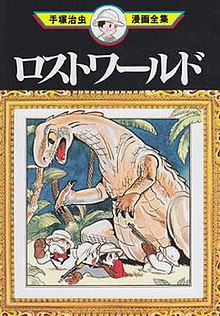Lost World (manga)
hideThis article has multiple issues. Please help or discuss these issues on the talk page. (Learn how and when to remove these template messages)
|
| Lost World | |
 The cover of Lost World | |
| ロスト・ワールド<前世紀> (Rosuto Waarudo <Zenseiki>) | |
|---|---|
| Genre | Science fiction, steampunk |
| Manga | |
| Written by | Osamu Tezuka |
| Published by | Fuji Shobo Akita Shoten |
| English publisher | |
| Magazine | Konsoi Yoron Newspaper, Boken-O |
| Published | December 20, 1948 |
| Volumes | 2 |
Lost World (ロスト・ワールド<前世紀>, Lost World - Zenseiki) is a manga series, written and illustrated by Osamu Tezuka in 1948.
Plot[]
A new planet begins to approach Earth. Scientists know nothing about the planet and decide to venture to it in order to discover its inhabitants and conditions. They discover that it is inhabited by dinosaurs and bears a resemblance to ancient Earth. The planet, named Mamango, broke off from Earth 5 million years ago and has come back for the first time since. The team soon discovers that criminals have stowed away on their space ship and that they have come to Mamango for their own devious reasons.
Characters[]
- Shunsaku Ban
- A detective investigating a murder that is somehow linked to the mysterious Planet Mamango.
- Kenichi Shikishima
- A bright young boy who realizes the powerful potential of rocks from Planet Mamango.
- Makeru Butamo
- A captain who pilots the rocket ship built by Kenichi to the Planet Mamango for an exploratory expedition.
- Sekken Kao
- A criminal who seeks the power of Planet Mamango.
- Doctor Jupiter
- A character modelled after Popeye (in fact, there are several American cartoon characters present in this book, including Dagwood and Mickey Mouse).
Publication[]
In Japan, Lost World was published in two volumes by Fuji Shobo. The first had the subtitle "The Earth", and the second was subtitled "The Universe"
When the English adaptation was published in the United States on July 30, 2003, both books were combined into a single volume .[1]
Legacy[]
Lost World is the first of Osamu Tezuka's early epic science fiction trilogy, consisting of Lost World (1948), Metropolis (1949) and Nextworld (1951). They were some of the earliest works featuring steampunk elements, which have since consistently appeared in mainstream manga. These steampunk elements eventually made their way into mainstream anime productions starting in the 1970s, with television shows including Leiji Matsumoto's Space Battleship Yamato (1974), Hayao Miyazaki's Future Boy Conan (1978), and the 1979 anime adaptation of Riyoko Ikeda's manga Rose of Versailles (1972).[2]
See also[]
References[]
- ^ Dark Horse Comics, Inc., "Official Lost World Page"
- ^ Cavallaro, Dani (2015). "Nadia: The Secret of Blue Water (Fushigi no Umi no Nadia)". The Art of Studio Gainax: Experimentation, Style and Innovation at the Leading Edge of Anime. McFarland & Company. pp. 40-53 (40-1). ISBN 978-1-4766-0070-3.
External links[]
- Official Lost World page at publisher Dark Horse Comics, Inc.
- Lost World (manga) at Anime News Network's encyclopedia
- Manga series
- 1948 manga
- Akita Shoten manga
- Dark Horse Comics titles
- Osamu Tezuka manga
- Science fiction anime and manga
- Steampunk anime and manga
